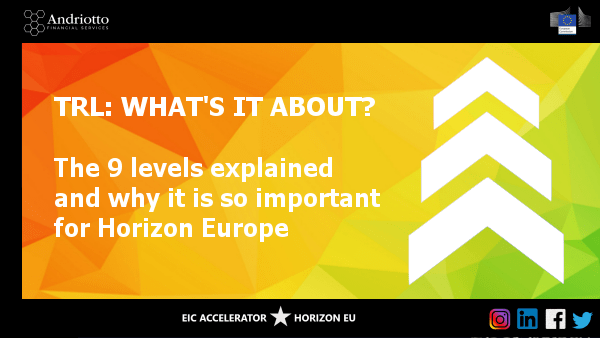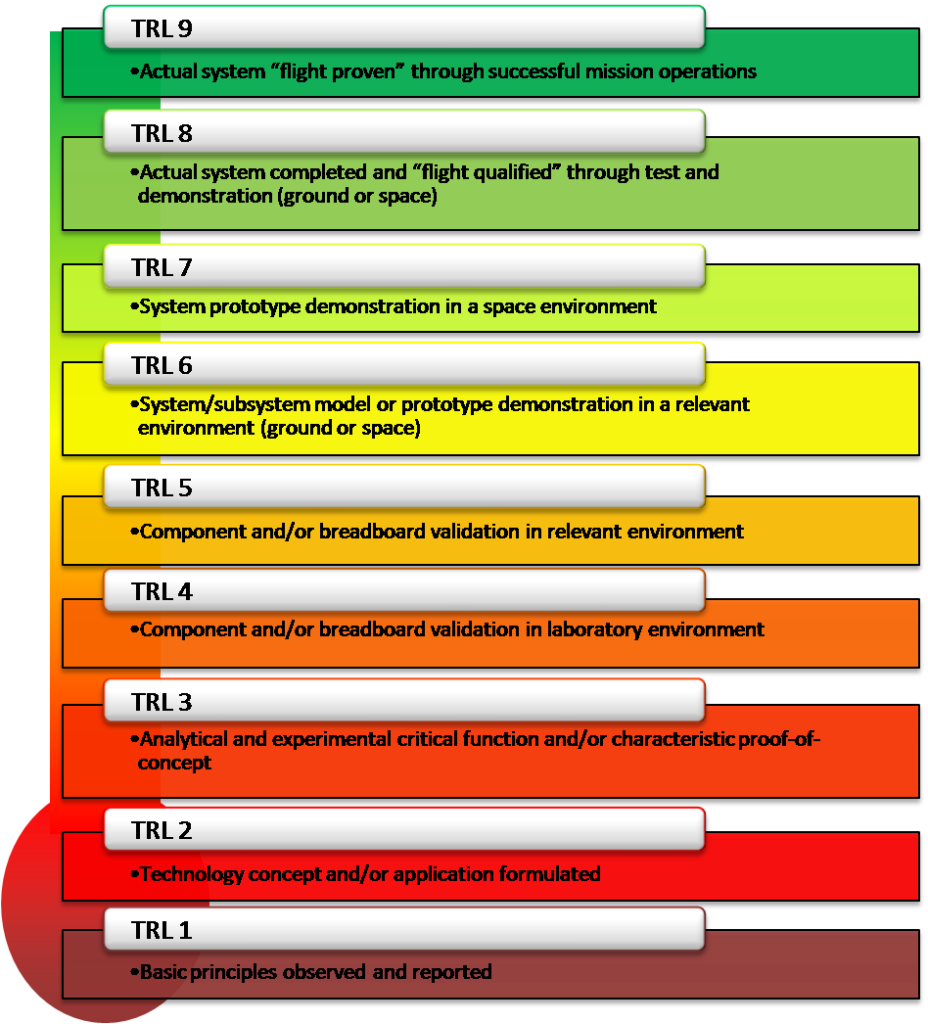The TRL (acronym for Technology Readiness Level) is a method employed to understand the maturity of technologies during the acquisition phase of a programme. It enables consistent and uniform discussions across different types of technologies, allowing precise development follow-up. The TRL spans from Level 1 to Level 9, which is the most mature stage.
In 2010, the European Commission advised EU-funded research and innovation projects to adopt it. Thus, in 2014, the EU Horizon 2020 programme extended the use of TRL to Horizon Europe.
Background: a little history
The concept was originally developed by NASA in the 1970s for space exploration technologies.
Technology Readiness Level (TRL)
Source: NASA
When a technology is at TRL 1, scientific research is beginning and those results are being translated into future research and development. TRL 2 occurs once the basic principles have been studied and practical applications can be applied to those initial findings. TRL 2 technology is very speculative, as there is little to no experimental proof of concept for the technology.
When active research and design begin, a technology is elevated to TRL 3. Generally both analytical and laboratory studies are required at this level to see if a technology is viable and ready to proceed further through the development process. Often during TRL 3, a proof-of-concept model is constructed.
Once the proof-of-concept technology is ready, the technology advances to TRL 4. During TRL 4, multiple component pieces are tested with one another. TRL 5 is a continuation of TRL 4, however, a technology that is at 5 is identified as a breadboard technology and must undergo more rigorous testing than technology that is only at TRL 4. Simulations should be run in environments that are as close to realistic as possible. Once the testing of TRL 5 is complete, a technology may advance to TRL 6. A TRL 6 technology has a fully functional prototype or representational model.
TRL 7 technology requires that the working model or prototype be demonstrated in a space environment. TRL 8 technology has been tested and “flight qualified” and it’s ready for implementation into an already existing technology or technology system. Once a technology has been “flight proven” during a successful mission, it can be called TRL 9.
Since then, many organisations have implemented TRLs for their own purposes (e.g., the European Union). This contributed to the normalisation of NASA’s readiness-level definitions, easing its translation to industry sectors other than just space exploration.
Explaining the 9 levels
In fact, the 9 different Technology Readiness Levels can be broken down into 3 main categories:
- Research: from Level 1 to Level 3
- Development: from Level 4 to Level 6
- Deployment: from Level 7 to Level 9
| Level | Description | What happens |
| 1 | Basic principles observed | Reports of scientific observations, paper-based studies of a technology’s basic properties |
| 2 | Technology concept formulated | Analytics studies, applications are speculative |
| 3 | Experimental proof of concept | Studies and laboratory measurements to validate the analytical predictions |
| 4 | Technology validated in lab | Analysis of the technology parameter operating range |
| 5 | Technology validated in relevant environment | Validation of a semi-integrated system or model of technological and supporting elements in a simulated environment |
| 6 | Technology demonstrated in relevant environment | Prototype system or model being produced and demonstrated in a simulated environment |
| 7 | System model or prototype demonstration in operational environment | Prototype mode or system verified in an operational environment |
| 8 | System complete and qualified | The knowledge generated from L7 is used to manufacture an actual system or model
In most cases, this TRL represents the end of development |
| 9 | Actual system proven in operational environment | The actual system or model is successfully deployed for multiple missions by end-users |
Many products go through the various stages of the TRL scale during their life cycle. Interactions might be needed between the various Levels, especially during the development phase. However, they are not limited to that.
The TRL is an effective method to indicate the stage of development of a product. Thus, it determines if the product is ready to be presented to customers and introduced into the market.
The “Valley of Death”: what is it?
In order to allow a technology to move from research to development stage, and then to deployment stage, addressing the TRL scale is required.
The term “Valley of Death” represents the TRL span from Level 4 to Level 7. Here, neither academia nor the private sector prioritise investment. Consequently, many technologies, albeit promising, do not reach the maturity that deployment requires.
In order to overcome this issue, collaboration is advised. One recommendation is to consult companies with experience in the field and that assist other companies with project development.
Andriotto Financial Services prides itself on various successes throughout the years. AFS has assisted many projects to obtain the funding needed to launch final products or innovative ideas on the market through European Grants. Currently, AFS is selecting companies, projects, start-ups and innovative ideas to access the fundings that the EIC Accelerator makes available through the Horizon Europe programme.
Is the TRL scale important for Horizon Europe?
The short answer is yes.
Horizon Europe uses the TRL scale as an indicator to rank the requested projects in the programme. In fact, Horizon Europe annual work programmes explicitly express that. This means that a higher TRL would indicate that a more applicative solution is required. A lower TRL, on the other hand, would indicate a more basic research-oriented solution.
The TRL, as a unified scale, enables applicants and reviewers to align with the expectations of the European Commission.
What is the “Entry Point”?
The “Entry Point” refers to the maturity Level given at the beginning stage of the project. As such, it serves as a lower boundary. Also, it helps meet the expectations of the European Commission in a specific call.
Companies must be aware of the correct stage of their project as they write the proposal. If the call specifically states an entry point, it is vital to meet the requirements. On the contrary, when not specifically stated, the TRL could be used to the company’s advantage.
The entry point can be used when describing the project, planning milestones, and setting evaluation measurements for the project. Please keep in mind that reviewers are asked to assess all of these issues. Therefore, it is in the company’s interest to be prepared on that subject as well.
As the TRL scale is self-declared, it is important to understand each of its levels. This is the best approach to perfectly determine the current Level of the project. Performing this evaluation, however, can be tricky.
Firstly, the definition may feel general at times. Secondly, transitions between Levels are often elusive. To add to it, comparison between disciplines is also impossible to carry out.
Nonetheless, this is a vital process that all applicants must go through. Again, in order to avoid issues, we strongly advise you to seek specialised consultancy service to write a unique and well-structured proposal.
TRL assessment and declaration
The assessment process begins with a meticulous check of the 9 Technology Readiness Levels. Specifically, we analyse titles and definitions, in order to perfectly meet the TRL scale for Horizon Europe (as the General Annex of the Grant Agreement defines).
Other helping tools are also available online:
- The TRL Calculator developed by the US Air Force Research Laboratory
https://www.afrl.af.mil/ - The TRL Calculator developed by the New York State Energy Research and Development Authority (NYSERDA)
https://www.nyserda.ny.gov
In conclusion, the TRL scale its vital in the context of Horizon Europe. However, using it correctly is far more important. To do so, one must fully understand its varying stages. This is the only way to correctly understand the specific Level to reference in the EIC proposal.
Naturally, a solid construct that meets the requirements has more chances to satisfy the European Commission’s interviews. This, in turn, allows the company to access the required fundings.
About Andriotto Financial Services (AFS):
- Andriotto Financial Services’ team is an official advisor of the European Commission for Horizon Europe.
- AFS has a Centre of Excellence in Switzerland with some of the most skilled EU grant specialists, writing successful proposals and supporting clients during different implementation phases of projects.
- AFS evaluates and selects the best projects and enterprises around Europe to receive public funding.
- Our client portfolio includes some of the most important public institutions in Italy and in Europe.
- Participating in Horizon Europe is an ambitious challenge. AFS has one of the highest success rates amongst our European competitors.
Are you looking to fund your next venture or unlock grant opportunities?
Reach out at [email protected]!



